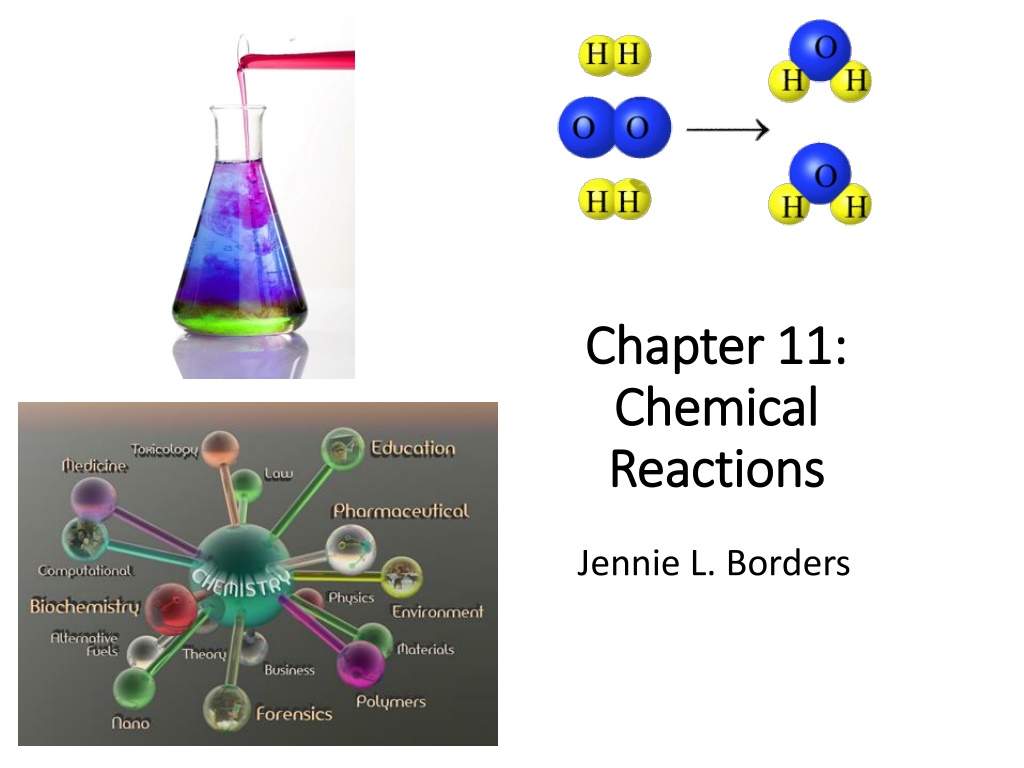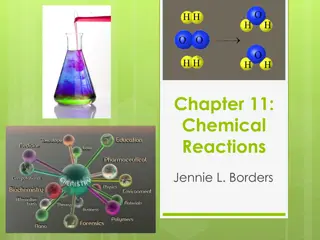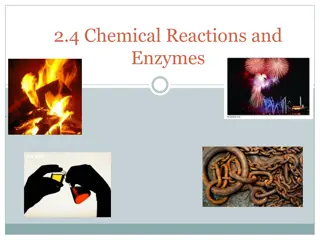Understanding Chemical Reactions in Chapter 11
Exploring chemical reactions in Chapter 11 includes describing reactions, using symbols in equations, understanding catalysts, and balancing chemical equations. Various sample and practice problems are provided to enhance comprehension and application of the concepts discussed.
Download Presentation

Please find below an Image/Link to download the presentation.
The content on the website is provided AS IS for your information and personal use only. It may not be sold, licensed, or shared on other websites without obtaining consent from the author. Download presentation by click this link. If you encounter any issues during the download, it is possible that the publisher has removed the file from their server.
E N D
Presentation Transcript
Chapter 11: Chapter 11: Chemical Chemical Reactions Reactions Jennie L. Borders
Section 11.1 Describing Chemical Reactions In a chemical reaction, the reactants are written on the left and the products on the right. The arrow that separates them is called yield. Reactants Products
Symbols in Equations Symbol " D (s) (l) (g) (aq) " " Meaning yields reversible reaction solid liquid gas aqueous catalyst heat Pt
Catalyst A catalyst is a substance that speeds up a reaction but is not used up in the reaction. A catalyst is neither a reactant nor a product, so its formula is written above the arrow in a chemical equation.
Word Equations To write a word equation, write the names of the reactants and products in a sentence form. Ex: chemical equation 2H2(g) + O2(g) 2H2O(l) Ex: word equation Hydrogen gas and oxygen gas react to form liquid water.
Sample Problem #1 Write a sentence that describes this chemical reaction: Na(s) + H2O(l) NaOH(aq) + H2(g)
Practice Problem #1 Write a sentence that describes this reaction: H2SO4(aq) + BaCl2(aq) BaSO4(s) + HCl(aq)
Sample Problem #2 Write the chemical equation for the following reaction: Hydrochloric acid and solid sodium hydrogen carbonate react to produce aqueous sodium chloride, water, and carbon dioxide. Hint: Acids will always be aqueous unless otherwise stated.
Practice Problem #2 Write the chemical equation for the following reaction: Solid iron(III)hydroxide is heated to form solid iron(III)oxide and water
Balancing Chemical Equations 2H2(g) + O2(g) 2H2O(l) oCoefficients are the numbers in front of a chemical formula. oSubscripts are numbers that show the number of atoms in a compound. oWhen balancing reactions, you can only change the coefficients, not the subscripts. oA skeleton equation is an equation that has no coefficients.
Balancing Chemical Equations To balance a chemical equation, you add coefficients to the substances so that the reactant and product side of the equation contain equals numbers and types of atoms. Coefficients are added so that the equation follows the law of conservation of mass.
Rules for Balancing Equations Balance hydrogen and oxygen last. Count a polyatomic ion as a single unit if it appears unchanged on both sides of the equation. If you end up with an odd number, you can double all of the coefficients. Make sure to reduce the coefficients to the lowest whole-number ratio. A coefficient of one is understood and does not need to be written.
Sample Exercise 1. The following diagram represents a chemical reaction in which the red spheres are oxygen atoms and the blue spheres are nitrogen atoms. D a. Write the chemical formulas for the reactants and products.
Sample Exercise b. Write the balanced equation for the reaction. c. Is the diagram consistent with the law of conservation of mass?
Practice Exercise In the following diagram, the white spheres represent hydrogen atoms, and the blue sphere represent nitrogen atoms. To be consistent with the law of conservation of mass, how many NH3 molecules should be shown in the right box?
Sample Problems Balance the following equations: 1. ___H2 + ___O2 ___H2O 2. ___AgNO3 + ___H2S ___Ag2S + ___HNO3 3. ___Zn(OH)2 + ___H3PO4 ___Zn3(PO4)2 + ___H2O
Practice Problems 1. ___FeCl3 + ___NaOH ___Fe(OH)3 + ___NaCl 2. ___CS2 + ___Cl2 ___CCl4 + ___S2Cl2 3. ___C2H6 + ___O2 ___CO2 + ___H2O
Section 11.1 Assessment 1. Describe the steps in writing a balanced chemical equation. 2. Write the skeleton equation for the following reactions: a. Heating solid copper(II)sulfide in the presence of oxygen gas produces pure copper and sulfur dioxide gas. b. Iron metal and chlorine gas react to form solid iron(III)chloride.
Section 11.1 Assessment c. Solid aluminum carbonate decomposes to form solid aluminum oxide and carbon dioxide gas. d. Solid magnesium reacts with aqueous silver(I)nitrate to form solid silver and aqueous magnesium nitrate.
Section 11.1 Assessment 3. Balance the following equations: a. ___SO2 + ___O2 ___SO3 b. ___Fe2O3 + ___H2 ___Fe + ___H2O c. ___P + ___O2 ___P4O10 d. ___Al + ___N2 ___AlN
Section 11.2 Types of Chemical Reactions The five general types of reactions are synthesis, decomposition, single displacement, double displacement, and combustion.
Synthesis Reactions In a synthesis reaction, two or more substances react to form one product. Synthesis reactions are also called combination reactions. Generic Reaction: A + B AB Actual Example: 2Mg + O2 2MgO
Predicting Products Predict the products for the following reaction: Cu + S (Hint: copper is +1) Write the balanced equation for the combination reaction that occurs when lithium metal and fluorine gas react. Write the balanced equation for the reaction that occurs when the surface of aluminum metal undergoes a combination reaction with oxygen in the air.
Decomposition Reactions A decomposition reaction occurs when a single reactant breaks down into two or more products. Generic Reaction: AB A + B Actual Example: 2HgO 2Hg + O2
Predicting Products Predict the products for the following reaction: H2O Write the balanced equation for the decomposition reaction that occurs when solid barium carbonate is heated to form barium oxide and carbon dioxide. Write the balanced equation for the reaction that occurs when solid mercury(II)sulfide decomposes into elements when heated.
Single Displacement Reactions A single displacement reaction occurs when one element replaces a second element in a compound. Generic Reaction: A + BC B + AC Actual Example: Zn + Cu(NO3)2 Cu + Zn(NO3)2
Predicting Products Predict the products for the following reactions: 1. Br2 + NaI 2. Fe + Pb(NO3)2 (Hint: iron is +3) 3. Zn + H2SO4 (Hint: zinc is +2)
The Activity Series A list of metals arranged in order of decreasing ease of oxidation is called an activity series. Active metals are at the top of the series and are most easily oxidized. Noble metals are at the bottom of the series are not very reactive. Any metal on the list can be oxidized by the ions of elements below it.
Sample Exercise Will an aqueous solution of iron (II) chloride oxidize magnesium metal? If so, write the balanced equation for the reaction.
Practice Exercise Which of the following metals will be oxidized by Pb(NO3)2: Zn, Cu, Fe?
Double Displacement Reactions A double displacement reaction involves the exchange of two positive ions between two compounds. Generic Reaction: AB + CD AD + CB Actual Example: 2NaCN + H2SO4 2HCN + Na2SO4
Predicting Products Predict the products for the following reactions: 1. CaBr2 + AgNO3 2. FeS + HCl 3. NaOH + Fe(NO3)3
Combustion Reactions A combustion reaction occurs when a substance burns in oxygen and produces a lot of heat and light. Examples: 2Mg + O2 2MgO CH4 + 2O2 CO2 + 2H2O
Combustion Reactions Many combustion reactions involve a hydrocarbon burning in air, and the products are CO2 and H2O as long as the combustion is complete. Generic Reaction: CxHy + O2 CO2 + H2O Actual Example: 2C8H18 + 25O2 16CO2 + 18H2O
Predicting Products Predict the products for the following reaction: C6H6 + O2 Write the balanced equation for the reaction that occurs when methanol, CH3OH is burned in air. Writhe the balanced equation for the reaction that occurs when ethanol, C2H5OH, is burned in air.
Section 11.2 Assessment 1. What are the five types of chemical reactions? 2. Classify the following skeleton reactions: a. C3H6 + O2 CO2 + H2O b. Al(OH)3 Al2O3 + H2O c. Li + O2 Li2O d. Zn + AgNO3 Ag + Zn(NO3)2
Section 11.2 Assessment 1. Complete and balance each equation: a. CaI2 + Hg(NO3)2 b. Al + Cl2 c. Ag + HCl (Hint: silver is +1) d. C2H2 + O2 e. MgCl2
Section 11.3 Reactions in Aqueous Solution A complete ionic equation is an equation that shows dissolved ionic compounds as dissociated free ions. A spectator ion is an ion that is not directly involved in a reaction. Compounds that are aqueous will break into ions, and compounds that are solid will remain bonded.
Aqueous Ions When a compound is aqueous it breaks into its ions. Ex: NaCl = MgBr2 = Al2O3 = LiNO3 = K2CO3 = Sr(NO2)2 =
Rules for Writing Complete Ionic Equations 1. Balance the equation. 2. Separate all aqueous substances into ions. 3. Leave any non-aqueous substances or precipitates together.
Complete Ionic Equations Regular Equation: AgNO3(aq) + NaCl(aq) AgCl(s) + NaNO3(aq) Complete Ionic Equation: Ag+(aq) + NO3-(aq) + Na+(aq) + Cl-(aq) AgCl(s) + Na+(aq) + NO3-(aq) If every ion in a complete ionic equation is a spectator, then no reaction occurs.
Sample Problem Write the complete ionic equation for the following reaction: FeCl3(aq) + KOH(aq) Fe(OH)3(s) + KCl(aq)
Practice Problems Write the complete ionic equation for the following reaction: NaOH(aq) + Fe(NO3)3(aq) Fe(OH)3(s) + NaNO3(aq)
Net Ionic Equations A net ionic equation shows only those particles involved in the reaction. The spectator ions have been removed. Ex: complete ionic equation 3Na+(aq) + 3OH-(aq) + Fe+3(aq) + 3NO3-(aq) Fe(OH)3(s) + 3Na+(aq) + 3NO3-(aq) When the spectator ions are removed, you are left with the net ionic equation: Fe+3(aq) + 3OH-(aq) Fe(OH)3(s)
Sample Problems To write a net ionic equation, you only consider non-aqueous substances and the ions that form them. Bi(NO3)3(aq) + H2S(aq) Bi2S3(s) + HNO3(aq) First, balance the equation: 2Bi(NO3)3(aq) + 3H2S(aq) Bi2S3(s) + 6HNO3(aq) Write only the ions involved in the reaction: 2Bi+3(aq) + 3S-2(aq) Bi2S3(s)
Practice Problems 1. Write the net ionic equation for the following reaction: Pb(NO3)2(aq) + H2SO4(aq) PbSO4(s) + HNO3(aq)
Practice Problems Write the net ionic equation for the following equation: Na3PO4(aq) + FeCl3(aq) NaCl(aq) + FePO4(s)
Gas Formation The sulfide ion and the carbonate ion will react with acids to form gases. Ex: S2- 2HCl(aq) + Na2S(aq) H2S(g) + 2NaCl(aq) Ex: CO32- HCl(aq) + NaHCO3(aq) NaCl(aq) + H2CO3(aq) H2CO3(aq) H2O(l) + CO2(g) So HCl(aq) + NaHCO3(aq) NaCl(aq) + H2O(l) + CO2(g)























